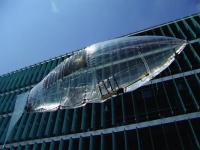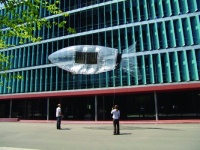
’We’re using the principle of fluid dynamical similarity to translate movement from water into the air,’ explained Christa Jordi, one of the researchers on the project at EMPA, the Swiss federal laboratory for materials research. ’We chose a rainbow trout because it’s a very general fish. It’s not a specialist in acceleration or manoeuvrability. It’s an all rounder.’
EMPA’s research project has so far resulted in an 8m-long ’Airfish’ prototype, which moves through air in the same way as a trout does in water – by bending its body in one direction and simultaneously moving its tail in the opposite way.
’We took a trial-and-error approach with this project,’ said Jordi. ’There’s always the question of whether we should do computer modelling or build it straight away, and we chose to do smaller-scale testing… it has been around four years of development and we are now working to optimise the design.’
“The use of active polymers means you don’t have to use a propeller, which makes it almost silent.”
Christa Jordi, EMPA
The version designed by the Swiss team involves three rigid, interconnected body segments that are flexed separately using dielectric electroactive polymers (EAPs) coated with carbon black particles. When the EAPs are activated with a high voltage, they are attracted to each other, becoming thinner and causing the material to compress. Using EAPs on either side of the body and the tail allows the Airfish to swoosh sideways, as well as back and forth. The team claims that because EAPs convert electrical energy directly into mechanical force without the need to use electric motors, they can reach energy efficiencies of up to 70 per cent. This compares with efficiencies of 25-30 per cent for a conventional airship.

Efficiency isn’t the only advantage of EAPs. ’Most airships generate a lot of sound,’ said Jordi. ’Generally, the larger the airship, the faster the propeller has to turn and at a certain point the propeller loses efficiency and becomes very loud. The use of active polymers means you don’t have to use a propeller, which makes it almost silent, and that could open up applications in surveillance or animal observation.’
The entire design, powered by lithium-polymer batteries, uses less energy than a piston-engine drive equivalent. It moves at a slow walking speed of half a metre per second and flies for around 20 minutes at a time. This isn’t long enough for real-life applications, admits Jordi, and combined with the fact that the EAPs only last a couple of months, there is still a lot of work to be done to make the Airfish into a commercial system.
Research is currently focusing on developing a different type of polymer to replace the EAPs, which would be made of silicone with silver electrodes. The researchers hope this will be longer lasting and more effective. ’If we can solve this problem, then there are a whole range of applications that will benefit from the use of EAPs,’ said Jordi. ’For instance, pump-like actions could prove valuable in the biomedical field for the development of things such as artificial muscles.’
Despite the limitations of EAPs, the Swiss researchers are confident that in the not-too-distant future, fish-shaped airships will be flying in our skies. They aren’t the only ones who have been inspired by underwater creatures. Pneumatics firm Festo has unveiled a remote-controlled manta ray-shaped airship that flies by flapping its wings rather than using a propeller. The propulsion is provided by a servo drive-controlled wing that moves up and down and uses a concept that the company has termed the ’fin ray effect’ which models fish fin behaviour when lateral force is applied.

’It’s quite peculiar in that if you apply a force halfway up one of these structures instead of bending away from you, it bends towards you,’ said Stephen Sands, UK marketing manager at Festo. ’We use this as the basic principle for the fin ray effect, which is just two flexible flanks and a series of flexible webs connected between them. By creating a small movement at the bottom of the two side flanks you get a far greater amplified movement at the tip.’
In Air Ray, the fin ray effect is created through a servo drive unit that pulls on two flanks in alternation. When pressure is exerted on one flank, the geometrical structure curves against the direction of the force allowing the wing module to move up and down. The concept is also used in another Festo design that has been inspired by the movement of jellyfish. ’AirJelly’ travels through the air using a helium-filled ballonet and a central electric drive unit connected to a group of eight spur gears.
“Looking at the movement of other airfish designs shows that there are lots of possibilities that we still have to explore.”
Christa Jordi, EMPA
’There are a lot of pneumatic models and other actuator concepts out there,’ said Jordi. ’EAPs aren’t ready for use in an airship right now, but they are interesting for inflatable structures because they are so soft and easily integrated. Looking at the movement of other airfish designs shows that there are lots of possibilities that we still have to explore.’
Festo is displaying its fish-inspired airships at the Royal Society’s annual science exhibition in London. The designs are only concepts, but both Jordi and Sands believe that the possibility of developing related devices, such as artificial muscles, will see fish become a valuable source of inspiration for engineers.
In depth
back to nature
Many inventions have benefitted from the natural touch
» Percy Shaw invented the cat’s eye reflectors in 1935 after he was inspired by the sight of his car head-lamps reflected in the eyes of a cat on a dark, foggy night.
» In 1948, Swiss engineer George de Mestral developed Velcro as a result of analysing cockleburs that had clung to his dog’s fur after a walk.
» Prof Julian Vincent at Bath University has developed a breathable ’smart’ material inspired by the action of the pine cone, which opens and closes according to varying humidity levels.
» Nanostructures and physical mechanisms that produce the colour of butterfly wings were reproduced in silicon-based materials by Greg Parker, professor of electronics and computer science at Southampton University.
» The panoramic and precise vision of flies and other insects has stimulated research into biologically inspired ’eyes’ for smart weapons and other self-guided machines.




Poll: Should the UK’s railways be renationalised?
I think that a network inclusive of the vehicles on it would make sense. However it remains to be seen if there is any plan for it to be for the...